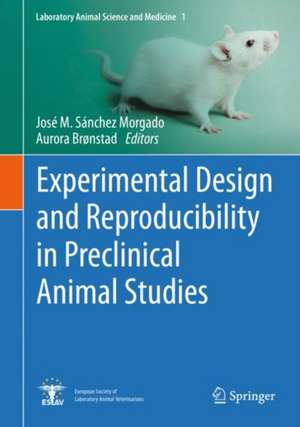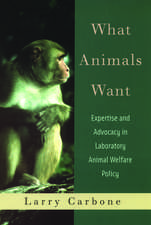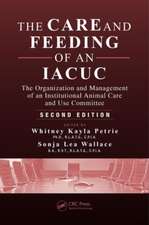Experimental Design and Reproducibility in Preclinical Animal Studies: Laboratory Animal Science and Medicine, cartea 1
Editat de José M. Sánchez Morgado, Aurora Brønstaden Limba Engleză Hardback – sep 2021
The book addresses advanced undergraduates, graduate students and all scientists working with animals.
| Toate formatele și edițiile | Preț | Express |
|---|---|---|
| Paperback (1) | 849.74 lei 3-5 săpt. | |
| Springer International Publishing – 2 sep 2022 | 849.74 lei 3-5 săpt. | |
| Hardback (1) | 1104.94 lei 38-44 zile | |
| Springer International Publishing – sep 2021 | 1104.94 lei 38-44 zile |
Preț: 1104.94 lei
Preț vechi: 1163.09 lei
-5% Nou
211.42€ • 220.77$ • 174.59£
Carte tipărită la comandă
Livrare economică 11-17 aprilie
Specificații
ISBN-10: 3030661466
Pagini: 277
Ilustrații: VI, 277 p. 52 illus., 39 illus. in color.
Dimensiuni: 178 x 254 mm
Greutate: 0.77 kg
Ediția:1st ed. 2021
Editura: Springer International Publishing
Colecția Springer
Seria Laboratory Animal Science and Medicine
Locul publicării:Cham, Switzerland
Cuprins
1. An introduction to reproducibility in the context of animal research
2. Rodent Genetics 2.1. Introduction to Mendelian genetics and genomics2.2. Standardized strains of laboratory rodents2.3. Genetically altered (GA) rodents 2.4. Genetic quality control for mice and rats
2.5. Mouse and rat phenomics
3. Animal and environmental factors that influence reproducibility
4. Microbiology and Microbiome
5. Effects of untreated pain, anesthesia and analgesia in animal experimentation
6. Why do we need a statistical experiment design?
7. Statistical tests and Sample size calculations
8. Design of experiments
9. Scholarly Publishing and Scientific Reproducibility
10. Systematic reviews
11. Planning animal experiments
Notă biografică
José M. Sánchez Morgado, DVM, MSc, PhD, Dip. ECLAM qualified as veterinarian at the Universidad Complutense of Madrid. He is European Veterinary Specialist in Laboratory Animal Medicine and Veterinary Council Ireland recognised Specialist in Laboratory Animal Medicine. Dr. Sánchez Morgado is currently Director of Comparative Medicine and Adjunct Associate Professor at Trinity College Dublin. He is also one of the Editors in Chief of the Laboratory Animals journal. Dr. Sánchez Morgado described a case of non-human primate intersex in 2003. Furthermore, he published studies on virulence of canine coronaviruses, Mycobacterium gordonae infection of amphibians, and on diagnostic discrepancies of Helicobacter spp., a common rodent pathogen, by different laboratories, and a new helicobacter diagnostic assay. He has worked as Designated Veterinarian in the UK, Spain and the Republic of Ireland, and has managed two laboratory animal care and user programs.
Aurora Brønstad, DVM, PhD, has been the chief veterinarian and head of the animal facility at University of Bergen (UiB), Norway, since 1999 where she also is responsible for the training in Laboratory Animal Science. She has been involved in several national and international committees, boards and network including the board of the Scand-LAS (2002-2008). She was member of the National Animal Research Authority (2003-2009), Norwegian delegate in Management Committee COST B24: Laboratory animal science and welfare (2004-2009), Nordic infrastructure for Mouse Models (IMM) WG4: Harmonization of procedures in animals handling and welfare (2008-2016), Board member of ILAB since 2009. Co-Chair of AALAS - FELASA working group on harm-benefit analysis of animal studies (2012-2016). Dr. Brønstad is member of the European Society of Laboratory Animal Veterinarians (ESLAV) since 2009 and served as the society’s President between 2017-2019. Further, she was appointed as an Ad hoc Consultant for the international Association for Assessment and Accreditation of Laboratory Animal Care (AAALAC) (2011-2016) and has also served in the AAALAC Council board since 2016. In 2016 she received the Charles River Award for the work in the American Association for Laboratory Animal Science (AALAS) - Federation of European Laboratory Animal Science Associations (FELASA) working group on harm-benefit analysis of animal studies, providing guidelines to advance the public’s understanding why animal models are used in research.
Textul de pe ultima copertă
This highly-readable text provides grounds on how to plan and conduct animal experiments that can be reproduced by others. The book touches on factors that may impact the reproducibility of animal studies including: the animal genetic background, the animal microbial flora, environmental and physiological variables affecting the animal, animal welfare, statistics and experimental design, systematic reviews of animal studies, and the publishing process.
The book addresses advanced undergraduates, graduate students and all scientists working with animals.
Caracteristici
Descriere
This highly-readable text provides grounds on how to plan and conduct animal experiments that can be reproduced by others. The book touches on factors that may impact the reproducibility of animal studies including: the animal genetic background, the animal microbial flora, environmental and physiological variables affecting the animal, animal welfare, statistics and experimental design, systematic reviews of animal studies, and the publishing process.
The book addresses advanced undergraduates, graduate students and all scientists working with animals.








